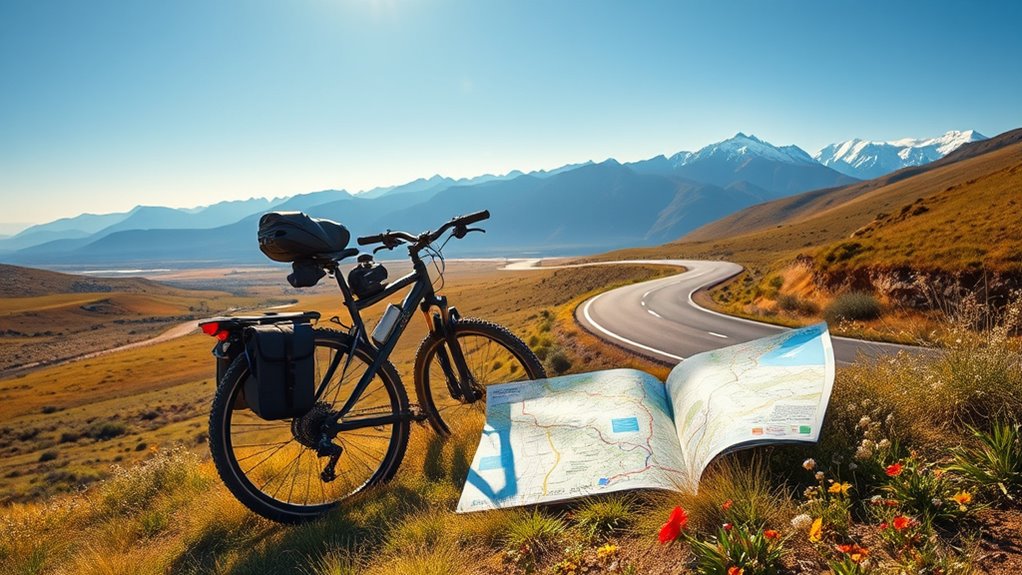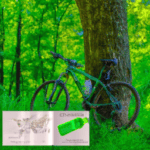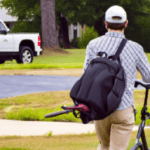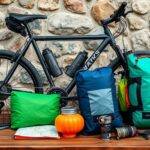To plan a cross-country bike tour, start by committing to daily workouts and gradually increasing your riding intensity. Pick a safe route, utilize bike maps, and break your journey into manageable segments. Pack essential gear, keeping your load light. Balance accommodations between camping and indoor options, and be flexible with your plans to adapt to unexpected challenges. Prioritize safety with proper gear and regular bike maintenance, and you’ll enjoy a rewarding adventure. Discover more tips for your journey ahead.
Key Takeaways
- Embrace uncertainty and prepare physically by cycling regularly, gradually increasing intensity and testing loaded gear.
- Plan your route using established bike paths, satellite imagery, and local insights to ensure safety and accessibility.
- Segment daily rides into manageable distances of 50-70 miles, incorporating rest days to prevent fatigue and allow for spontaneity.
- Pack efficiently, including only essential gear and keeping weight under 50 pounds, while organizing items into dry and wet categories.
- Prioritize safety by wearing reflective gear, performing regular bike maintenance, and securing your bike with high-quality locks.
Trip Commitment and Preparation
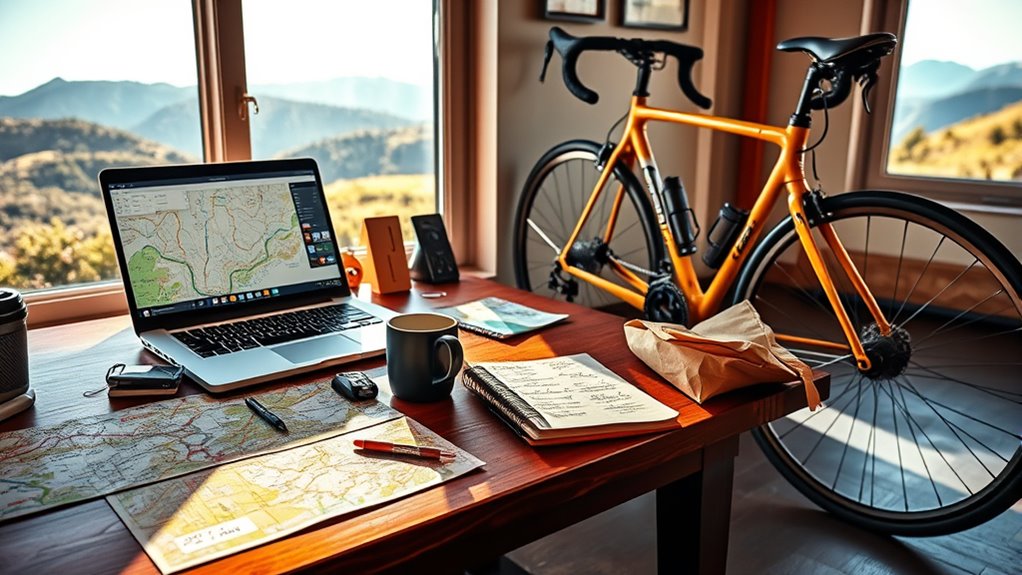
Committing to a cross-country bike tour is a significant step that requires embracing uncertainty. You might feel unprepared until you actually start your journey.
To guarantee your trip commitment is solid, it’s crucial to get physically ready. Engage in daily workouts and ride 3-4 times a week, gradually increasing intensity. Test biking with varying weights can help you adjust to your loaded gear, making the long bike tour feel more manageable.
Limit your packing to essentials, like bike jerseys and rain gear, tailored to the expected weather. Don’t forget to take long test rides to acclimate to the weight of your bike. Additionally, consider using natural language processing to communicate effectively with fellow travelers and seek advice online, enhancing your preparation experience.
This preparation helps you tackle the mental and logistical challenges ahead of your adventure.
Route Planning and Logistics

Planning your route is an essential step in ensuring a successful cross-country bike tour. Start by considering established bike routes like the TransAmerica Trail or U.S. Bicycle Routes for safer navigation and crucial amenities.
Utilize tools like RideWithGPS.com and satellite imagery to connect your desired locations, identifying any gaps that may require local state bicycle maps. Choose your start and endpoints wisely, especially for one-way trips, factoring in logistics for transporting your bike and gear.
Research average weather patterns along your route to avoid hazardous conditions, adjusting your plans accordingly. Additionally, consider the impact of color accuracy on your navigation tools, as precise visuals can significantly enhance your planning process.
Finally, plan daily segments with manageable ride distances of 3-5 days, ensuring accommodations and food availability to support your bike touring adventure.
Daily Ride Planning and On-the-Road Strategies

With your route mapped out, it’s time to focus on daily ride planning and on-the-road strategies that will keep you energized and motivated. Consider these essential tips for your bike trip:
- Segment Your Rides: Aim for daily ride segments of 50-70 miles, adjusting for terrain and your endurance levels.
- Plan Your Stops: Schedule breaks for hydration and nutrition, targeting 60-90 grams of carbohydrates per hour to sustain your energy.
- Mix Accommodations: Balance your stays with camping and indoor options—try one out of every three nights camping to save costs and enhance the adventure.
Incorporating rest days every 5-7 days also helps prevent fatigue, making your touring bike journey more enjoyable. Additionally, consider picking your travel times to avoid increased turbulence during the evening, ensuring a smoother ride experience.
Happy riding!
Gear Essentials and Packing Strategies
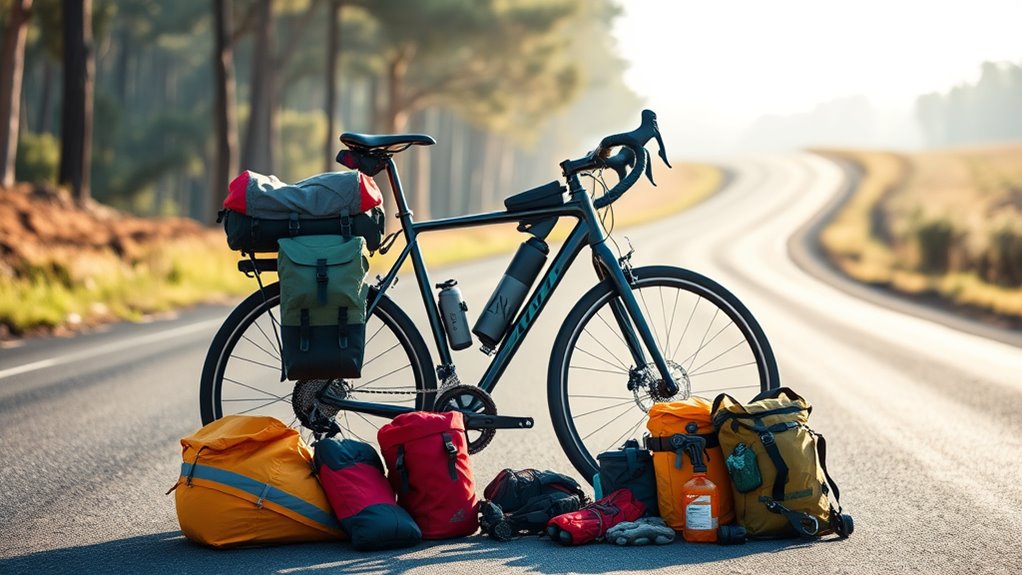
Gear is the backbone of a successful cross-country bike tour, and choosing the right equipment can make all the difference.
Start with a durable touring bike featuring a steel frame and fat tires for stability on various terrains. Get it professionally fitted for ideal comfort.
Invest in high-capacity waterproof panniers to keep your gear dry, and add a handlebar bag for easy access to snacks and personal items.
When it comes to packing strategies, organize your gear into clean/dry and dirty/wet categories, aiming for a total weight of no more than 50 pounds.
Keep essential bike tools like a pump and spare tubes handy, and prioritize versatile clothing. Additionally, consider using lightweight models to ensure ease of handling while riding.
Consider mailing extra items to lighten your load as you travel.
Safety Precautions and Challenges

When you hit the road for your cross-country bike tour, staying visible is essential, so wear bright colors and reflective gear. Regular bike maintenance will help you avoid breakdowns, while keeping your bike locked and in sight protects against theft. Always be ready for unexpected challenges and guarantee you’ve got a solid plan for safety. Additionally, familiarize yourself with common safety tips to ensure a smooth and enjoyable journey.
Visibility and Gear Maintenance
Guaranteeing your safety on a cross-country bike tour hinges on two key aspects: visibility and gear maintenance.
To enhance your visibility and stay safe, follow these tips:
- Wear bright colors and reflective gear to stand out, especially in low light conditions.
- Use front and rear lights on your bike and helmet to guarantee you’re seen by motorists.
- Perform regular gear maintenance, including tune-ups and checking brake systems, to prevent mechanical failures.
Visit local bike shops to get the tools you need, like a pump and spare tubes, for quick repairs.
Implement a maintenance schedule that includes cleaning and lubricating your bike to extend its lifespan and improve your overall safety while riding. Regular maintenance can prevent issues that may arise from frequent part replacements similar to those seen in pool cleaners.
Theft Prevention Strategies
Protecting your bike from theft is essential during a cross-country tour, as it can mean the difference between a smooth journey and a frustrating setback.
Always use a high-quality U-lock or chain lock to secure your bike in well-lit, busy areas. Thieves are less likely to target bikes in visible spots with foot traffic and security cameras.
Consider adding a bike alarm or GPS tracker; these can alert you to tampering and aid in recovery if your bike is stolen.
Don’t forget to remove easily detachable items like lights, pumps, and bags before leaving your bike unattended.
Finally, register your bike with a national bike registry to improve your chances of getting it back if it’s stolen. Additionally, implementing effective decluttering strategies in your gear can help minimize what you carry, making it easier to secure your bike and its belongings.
Accommodations and Food

When you’re planning your cross-country bike tour, figuring out where you’ll eat and sleep is essential.
You’ll want to explore various accommodation options, from campsites to local hosts, while also strategizing your meals to keep energy levels up.
With the right planning, you can enjoy a comfortable journey filled with delicious food and restful nights. Additionally, consider the benefits of camping locations to enhance your touring experience while connecting with nature.
Meal Planning Strategies
While planning your cross-country bike tour, you’ll want to prioritize meal preparation to keep your energy up on the road. Here are some effective meal planning strategies:
- Pack Non-Perishables: Bring energy bars, nuts, and dehydrated meals for nutrition on the go.
- Research Food Stops: Use state bicycle maps and apps to find local grocery stores, diners, and restaurants along your route.
- Consult Adventure Cycling Maps: These often highlight services, including food options, making it easier to plan your meals.
Don’t forget to prepare for unexpected closures by carrying extra snacks and beverages.
Engaging with Warmshowers hosts or locals can also uncover hidden gems for delicious meals during your tour, ensuring you stay fueled for your adventure! Also, consider incorporating portable camping toilets in your planning for added convenience during your stops.
Accommodation Options Available
Finding the right accommodations is essential for a successful cross-country bike tour. As you navigate your planning process, consider a mix of accommodation options like camping, hotels, Airbnb, and WarmShowers hosts.
Aim to camp about one-third of the nights to save costs, while choosing indoor options for longer stretches to avoid fatigue. Use Adventure Cycling’s bicycle route maps to locate essential services, such as food and shelter, along your route.
It’s wise to research amenities like restrooms and dining options in advance, especially since some services may be closed unexpectedly in remote areas. Ultimately, engage with local residents and fellow cyclists to uncover hidden gems for lodging and dining that mightn’t appear in conventional guides. Additionally, remember that proper storage of food can significantly affect your energy levels during the tour.
Filling in the Gaps
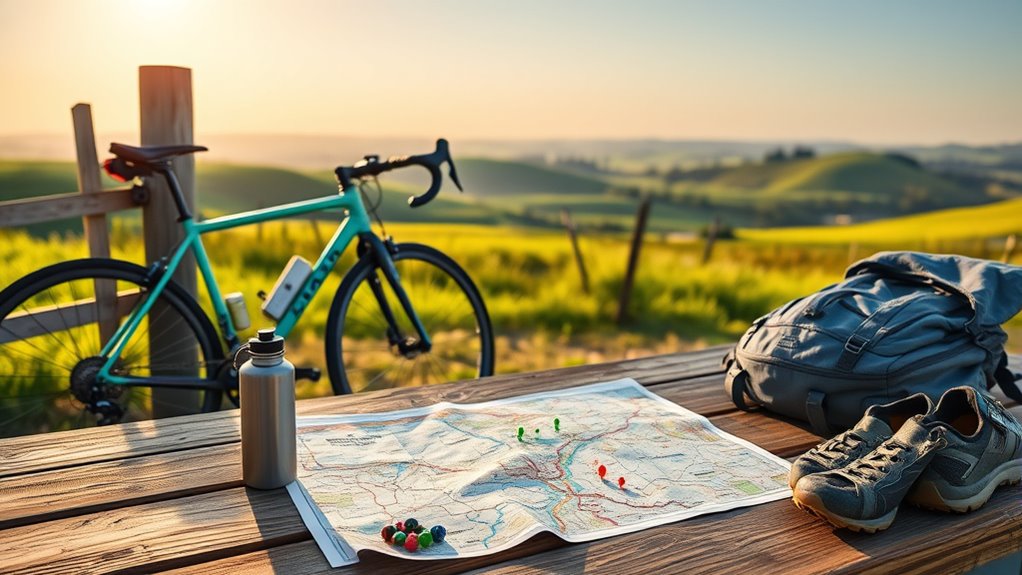
As you plan your cross-country bike tour, it’s crucial to fill in the gaps between your selected destinations to guarantee a smooth journey.
Here are three key strategies to keep in mind while planning your route:
- Research state bicycle maps: These can provide vital connections between your desired destinations.
- Utilize U.S. Bicycle Routes: These routes are designed specifically for long-distance biking across the country, offering safer options.
- Engage with locals: They can offer invaluable insights on traversing tricky areas and recommend the best routes that maps might overlook.
Lastly, exercise caution when using online route planners, as they may not always factor in bike-friendly paths or current road conditions.
Being prepared for unexpected challenges will help secure a successful tour.
Importance of Flexibility
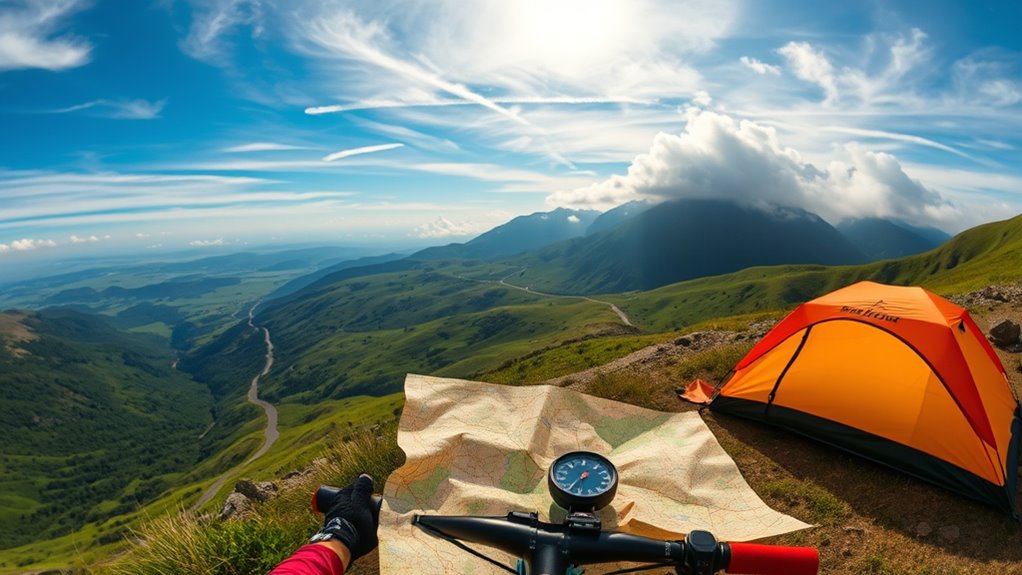
Embracing flexibility in your cross-country bike tour can transform your adventure, allowing for spontaneous experiences and enriching interactions with locals.
You’ll encounter unforeseen challenges like sudden weather changes or route difficulties, so being adaptable is key to ensuring your journey remains safe and enjoyable.
Incorporating flexibility into your daily plans helps you accommodate varying energy levels and unplanned stops, leading to memorable discoveries along the way.
Don’t forget to build in downtime—rest days are essential for preventing fatigue and allowing you to fully appreciate the scenery.
Frequently Asked Questions
How to Do a Cross-Country Bike Trip?
To do a cross-country bike trip, start by choosing a route that suits your experience level.
Make sure you train by gradually increasing your biking distance.
Pack essential gear, focusing on lightweight and durable items.
Plan your daily segments, keeping your distances manageable.
Don’t forget to include food and rest stops.
Stay flexible to adjust your plans as needed, and embrace the challenges for a rewarding adventure.
Enjoy the journey!
How Long Does a Cross-Country Bike Trip Take?
A cross-country bike trip can feel like a journey through time, stretching anywhere from two to four months.
You’ll likely cover 50 to 100 miles each day, but don’t forget to factor in weather conditions and terrain, which can slow you down.
Incorporating rest days is essential for recharging, even if it stretches your timeline.
Ultimately, how long it takes depends on your pace, preparation, and the experiences you choose to embrace along the way.
How to Plan Your Own Bike Tour?
To plan your own bike tour, start by choosing your starting point and destination. Use online tools like RideWithGPS to map out routes and check state bicycle maps for reliable paths.
Break your journey into manageable segments, allowing for food and rest stops. Pack light, prioritizing waterproof gear, and test your equipment on training rides.
Finally, connect with local cyclists for tips and support, ensuring a smoother and more enjoyable adventure.
Is It Realistic to Bike 20 Miles a Day?
Sure, biking 20 miles a day sounds like a walk in the park—if that park is Everest!
But seriously, for most cyclists, it’s totally realistic, especially if you pace yourself and build up your stamina.
Beginners might struggle at first, but with practice, you’ll find it’s manageable.
Just remember, flat routes are your friends.
Conclusion
As you begin your cross-country bike tour, think of yourself as a wandering river, carving your path through the landscape. Embrace the twists and turns, the highs and lows, and let each pedal stroke be a brushstroke on the canvas of your journey. Remember, it’s not just about reaching the destination but savoring every moment along the way. So, pack your spirit of adventure, and let the open road guide you to new horizons.
